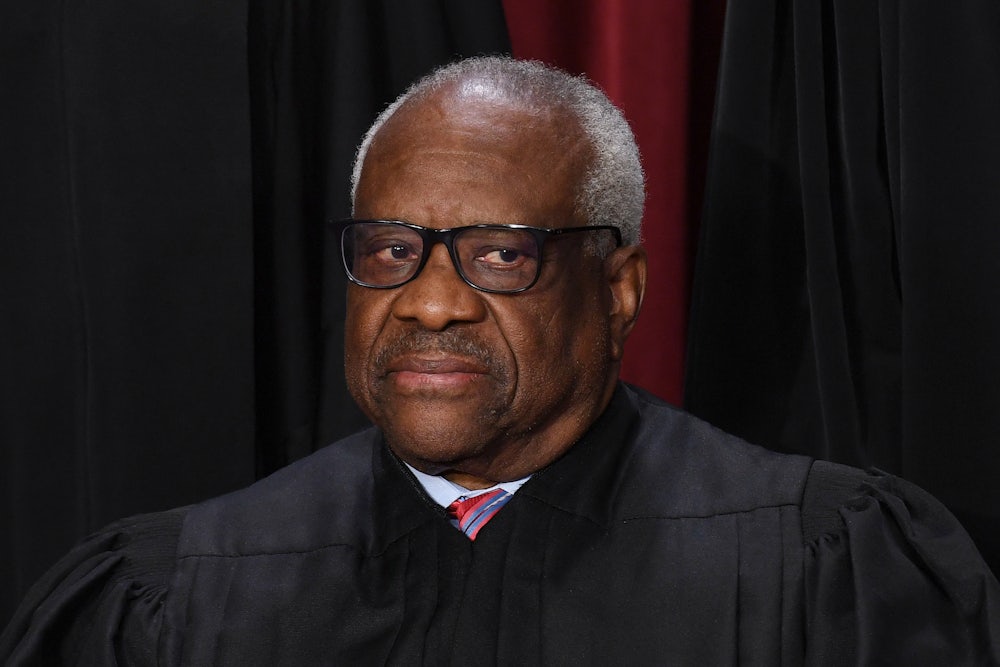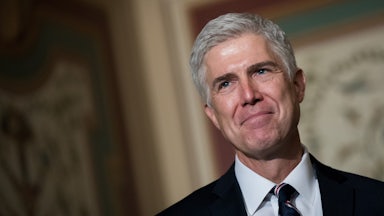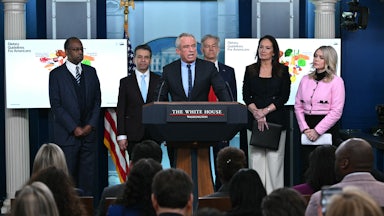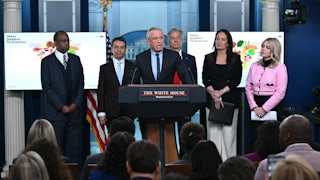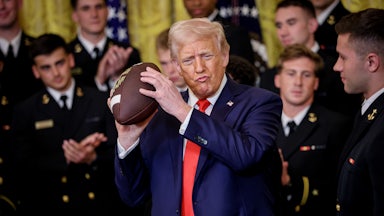Justice Neil Gorsuch’s writings on Indian law have received plenty of attention in recent years. The court’s only Westerner has set himself apart from his colleagues on the left and the right for his strong defenses of tribal sovereignty, his empathetic understanding of Native American history, and his ability to write about one of the most complicated areas of the American legal system with unusual clarity.
He continued that trend in Thursday’s ruling in Navajo Nation v. Arizona, where the court decided against the tribe’s efforts to compel the federal government to enforce its water rights. Writing for himself and the court’s three liberal justices, Gorsuch dissented from the ruling. “As they did at Bosque Redondo,” he wrote, referring to the site of an 1868 treaty, “[the Navajo] must again fight for themselves to secure their homeland and all that must necessarily come with it. Perhaps here, as there, some measure of justice will prevail in the end.”
This time, however, Gorsuch’s might not be the opinion that truly stands out. Justice Clarence Thomas wrote a solo concurring opinion where he explained that while he agreed with the majority’s reasoning in full, he was writing separately because he thinks that the court should “clarify” some of its most important Indian law and tribal sovereignty rulings—meaning that he thinks they should be overturned. Doing so would upend two centuries of federal-tribal relations and fundamentally reshape Native Americans’ place in the American constitutional order.
Thursday’s dispute sprang from the Colorado River. The scarcity of water in much of the American West has led to unique legal structures to ensure it is fairly allocated. One of those structures is the Colorado River Compact, which Congress and seven states established in 1922. It divides the river into upper and lower portions and sets out specific water allotments for each state to receive. As the Western population has grown and droughts have lowered the amount of available water, these allotments have taken on even greater importance.
The Navajo Nation is not part of the Colorado River Compact or its allotment formula, even though its reservation is within the river’s watershed. While some tribal reservations are quite small, the Navajo lands are not: They span most of northeastern Arizona as well as notable portions of Utah and New Mexico. More than 160,000 people live there, making it the most populous reservation in the United States. As the Navajo Nation observed in its brief for the Supreme Court last year, obtaining potable water is often difficult. Roughly one-third of the Navajo Nation’s inhabitants don’t have access to running water, for example.
“While the average American uses 80–100 gallons of water per day for household needs, Navajo Nation members use about seven,” it explained. “The resulting difficulty in maintaining hand hygiene contributed to a Covid-19 death rate higher in the nation than in many other parts of the United States. And droughts have only made things worse.”
In 1868, Navajo leaders signed the treaty that Gorsuch referenced, establishing the reservation in what would later become the state of Arizona. The agreement came after the U.S. had carried out a scorched-earth military campaign against the Navajo and then forcibly relocated Navajo men, women, and children to eastern New Mexico. Survivors later referred to the ordeal as the “Long Walk.” Many of the Navajo died en route to Bosque Redondo, from starvation, exposure, or violence by U.S. troops who oversaw the march. A further 2,000 died on the parched, nonarable land onto which they had been relocated before the government allowed them to return to their ancestral lands.
The Supreme Court’s Indian-law jurisprudence has long held that the U.S. has a trustee relationship of sorts with tribal governments. In the 1908 case Winters v. United States, the justices also ruled that these responsibilities extended to water rights. The Winters court concluded, logically, that without water access the tribal reservations onto which many Native communities had been relocated could not survive. The Navajo Nation sued in Thursday’s case to force the federal government to uphold those water rights, ensuring them access to part of the Colorado River. (The case is titled Navajo Nation v. Arizona because some of the Colorado River states intervened in the litigation in the lower courts.)
Justice Brett Kavanaugh, writing for a five-justice majority, read the Navajo Nation’s treaty with the federal government more narrowly than the tribe. He concluded that while the treaty imposed a series of requirements on the U.S., including providing teachers for local schools, agricultural implements, and even clothing, it contained no specific language about water rights. Without that language, the government had no legally binding responsibility for the court to enforce.
“In the tribe’s view, the 1868 treaty imposed a duty on the United States to take affirmative steps to secure water for the Navajos,” Kavanaugh wrote. “With respect, the tribe is incorrect. The 1868 treaty ‘set apart’ a reservation for the ‘use and occupation of the Navajo tribe.’ But it contained no ‘rights-creating or duty-imposing’ language that imposed a duty on the United States to take affirmative steps to secure water for the tribe.”
Kavanaugh also noted that while the U.S. does have a trustee relationship with the Navajo Nation and with other tribes, the federal government is not required to adopt every responsibility that a normal fiduciary might have since it is a sovereign nation. To that end, he concluded, the tribe’s best course of action would be to seek assistance from Congress or the executive branch. In Kavanaugh’s view, there was nothing for the judiciary to enforce in this case.
Unsurprisingly, Gorsuch wrote a lengthy dissent. His 27-page opinion is more than twice as long as Kavanaugh’s. While Gorsuch did not castigate his colleague in the same harsh tones that he used in last year’s ruling in Oklahoma v. Castro-Huerta, he nonetheless argued that the majority had misread what the Navajo Nation was asking for. “Asking the federal government to assess what it holds in trust and to ensure that it is not misappropriating water that belongs to the Tribe has nothing to do with building pipelines or farming land,” Gorsuch wrote.
I wrote last week when the court declined to overturn the Indian Child Welfare Act, or ICWA, that Gorsuch and Thomas had laid out two dueling originalist visions of the court’s Indian-law jurisprudence. In Thursday’s water rights ruling, the justices did not repeat their arguments outright. But Thomas did expand upon his criticism of those precedents, this time by targeting the idea that the U.S. had a trustee relationship with the tribes at all.
“The text of the Constitution (which mentions Indians only in the contexts of commerce and apportionment) is completely silent on any such trust relationship,” Thomas wrote. “Further, the trust relationship does not have any historical basis. Its genesis is usually traced to this Court’s statement in Cherokee Nation v. Georgia, that the relation of the United States to Indians has ‘resembl[ed] that of a ward to his guardian.’”
That 1831 ruling by Chief Justice John Marshall held that Native American tribes could not invoke the high court’s original jurisdiction, which allows it to directly hear lawsuits by foreign governments, because the Cherokee Nation and other tribes were considered “domestic dependent nations.” Marshall’s ruling, including his description of the ward-guardian relationship, is foundational to Indian law and shapes almost every aspect of tribal governance today.
“However, that [ward-guardian] statement was dicta, and, in any event, the Indian tribe in that case had a specific treaty calling for the federal government’s ‘protection,’” Thomas wrote, using a Latin term for portions of a court’s ruling that are not central to its holding to downplay its significance. “Some treaties with tribes have contained similar provisions; others have not. And, of course, some tribes before and after the Founding engaged in warfare with the federal government. In short, the idea of a generic trust relationship with all tribes—to say nothing of legally enforceable fiduciary duties—seems to lack a historical or constitutional basis.”
Thomas is more willing to call for the court’s precedents to be overturned than any of the other justices, even those who share his ideological stances. Justice Antonin Scalia once told one of his colleagues’ biographers that Thomas “does not believe in stare decisis, period,” referring to the legal doctrine that counsels American judges to base their rulings on precedent. This has placed him on the court’s ideological fringes for most of his tenure. “Look, I’m an originalist, but I’m not a nut,” Scalia once said in reference to Thomas’s approach.
This time, however, Thomas may not be alone. In oral arguments last year in a case on state authority over tribal casinos, Justice Samuel Alito briefly questioned the Indian canon, which refers to a set of rules of construction that judges use to interpret treaties and statutes that affect Native Americans. “Those who favor the interpretation of statutes to mean what the words of the statute are generally understood to mean have some questions about some of these substantive canons,” Alito asked one of the lawyers, referring to textualists like himself. He noted that “some of them, like the rule of lenity, have a long history,” implying that others like the Indian canon do not.
And in Thomas’s concurring opinion on Thursday, he cited a law-review article published by professor Amy Coney Barrett in 2010 where she discussed the Indian canon as part of a broader look at judicial canons of construction. Barrett did not explicitly criticize the canon—she even took care to explain that she was not saying federal courts were wrong to apply it—but Thomas used her discussion of it to further his overall argument. “To this day, it remains unclear how the ‘trust relationship’ could justify freestanding pro-Indian canons that authorize courts to depart from the ordinary rules of statutory interpretation,” Thomas argued.
Thomas singled out a few prior cases where he thought the court should “clarify the exact status of this amorphous and seemingly ungrounded ‘trust relationship.’” Perhaps the most notable of them was Morton v. Mancari, a 1974 case that established that federal laws and policies that benefit Native Americans generally don’t violate the equal protection clause. The justices reasoned that tribal membership is a political classification, not a racial one, and that the Constitution empowers the federal government to legislate for tribes in ways that it otherwise could not.
The current justices declined to disturb Mancari in last week’s ruling after they ruled the parties did not have a standing for it. But Justice Brett Kavanaugh signaled in a concurring opinion that he would be open to considering it in a future case, and conservative legal activists will likely try to find a way to bring it before the justices again. If the court reverses Mancari, then laws that specifically benefit tribes could be challenged as racial discrimination under the equal protection clause. The legal threshold for laws to survive that test is virtually insurmountable, and the court is likely to raise it even higher in its ruling on affirmative action in college admissions later this month.
Gorsuch did not address Thomas’s concurring opinion in his own dissent from Thursday’s ruling. But his colleague’s call to effectively demolish decades of Indian-law precedents may help explain some of Gorsuch’s passion for tribal sovereignty cases since joining the court. Gorsuch’s writings on this topic stand out in part because of their eloquence, but while some of them have also had significant real-world impacts, he has typically done little more than affirm existing precedents instead of circumventing them to rule against the tribes.
His ruling in McGirt v. Oklahoma, which recognized that more than Oklahoma was still Indian country, drew public attention for its powerful descriptions of the Trail of Tears and the injustices faced by the tribes that were forcibly relocated. But at its core, it was essentially a straightforward application of Solem v. Bartlett, a 1984 case where the court held that Congress must be explicit when disestablishing a tribal reservation. In Oklahoma v. Castro-Huerta, a follow-up to McGirt that limited it by giving states the power to prosecute certain crimes in Indian country, Gorsuch vividly denounced Kavanaugh’s majority opinion for defying two centuries of Indian law precedent. In last week’s ICWA ruling, Gorsuch argued in favor of the statute’s constitutionality based largely on long-standing principles in Indian law even while he also sought to reshape them within an originalist framework.
As I’ve noted before, court watchers have struggled to find a satisfying explanation for why Gorsuch is so interested in these cases. Justices Anthony Kennedy and Stephen Breyer also came from the West Coast, after all, and they showed no special interest in tribal affairs. Based on his previous writings, I theorized a few months ago that Gorsuch strongly believes that tribal governments are a legitimate part of the American constitutional order—a perspective that might seem mundane for most laypeople but is, to put it mildly, somewhat unusual for a Supreme Court justice. Thomas’s stated willingness to overthrow much of Indian law in this month’s case could also explain Gorsuch’s passionate defenses of it.
It is impossible to tell exactly what happens behind closed doors at the court, of course. But Thomas’s and Gorsuch’s dueling opinions and some of the court’s post-McGirt rulings strongly suggest that there’s an ongoing debate among the conservative justices over the fundamental nature of tribal sovereignty. Thomas’s writings will likely signal conservative legal activists to bring litigation that could force the question. Gorsuch, who is all too familiar with the darkest chapters of American history on this subject, appears to be trying to persuade his colleagues not to make the same mistakes as past generations of American leaders. If he is unsuccessful, the consequences for Indian country could be incalculable.
